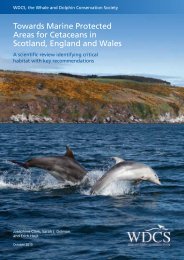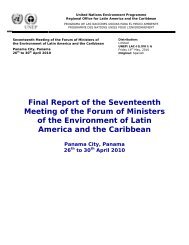Sea Turtle Recovery Action Plan for Barbados - WIDECAST
Sea Turtle Recovery Action Plan for Barbados - WIDECAST
Sea Turtle Recovery Action Plan for Barbados - WIDECAST
Create successful ePaper yourself
Turn your PDF publications into a flip-book with our unique Google optimized e-Paper software.
CEP Technical Report No. 12<br />
hatchlings emerging from nests exposed to beach front lighting have been found orienting away<br />
from the sea and toward the artificial light source (section 3.1). While there are presently no<br />
official regulations with regard to the lighting of beach front properties, several means to<br />
mitigate the problems caused by badly placed lights have been employed. These include the<br />
sending of a <strong>for</strong>m letter to all hotels and restaurants along the west and south coasts early in the<br />
hawksbill breeding season. The letter asks that unnecessary lights be turned off, and that lights<br />
which cannot be turned off <strong>for</strong> security and safety reasons be checked each morning at dawn <strong>for</strong><br />
disorientated hatchlings. This letter has produced very encouraging results. Bellairs Research<br />
Institute staff collect disoriented hatchlings <strong>for</strong> release at a suitable beach the following night.<br />
Another approach has been to talk directly with architects and their clients about lighting<br />
plans <strong>for</strong> new developments along the coast (see section 4.621). When alerted to the problems<br />
caused by beach illumination, developers have proved to be quite willing to cooperate even in<br />
the absence of legal requirements to do so. Lighting problems can be minimized by keeping<br />
lights low to the ground, shielding them from shining directly on the beach (this is accomplished<br />
using structural shields or attractive hedges of vegetation), and using low sodium vapor lamps<br />
which emit light in the range of 590 nm, which is known to be far less attractive to hatchlings<br />
than full-spectrum white lights (Raymond, 1984; Witherington, 1990). Although it would be<br />
beneficial, it is very unlikely that any lighting restrictions will be legislated in the <strong>for</strong>eseeable<br />
future. Thus, voluntary compliance with lighting alternatives and restrictions is seen as crucial to<br />
the reproductive success of sea turtles in <strong>Barbados</strong>.<br />
4.133 Beach stabilization structures<br />
Beach erosion is a serious problem on the west and south coasts of the island (section<br />
3.1). Many properties built be<strong>for</strong>e legislation governing set-back limits were en<strong>for</strong>ced have<br />
erected beach walls, or revetments such as rock-filled wire baskets (gabions) or boulders to<br />
minimize loss of their land to the sea. For much of the coastline, turtles are unable to climb very<br />
far above the normal high water mark due to these coastal protection structures. The annual loss<br />
in beach width of 0.3 m along the west coast means that there is likely to be an increasing need<br />
<strong>for</strong> coastal protection and armouring in the near future. This will decrease the amount of suitable<br />
nesting habitat left available to hawksbills if the structural solutions to coastal erosion outlined<br />
above (e.g., the placement of boulders) are implemented. Some hotels have also erected groynes<br />
in attempts to increase the width of their beaches. These groynes have altered sand movements<br />
along extensive stretches of the coast and have sometimes resulted in the complete loss of<br />
adjacent beaches at certain times of the year. On some beaches, sea turtle nesting may also have<br />
been adversely affected (see also section 4.135).<br />
The conservation of beaches in <strong>Barbados</strong>, because of their social and economic<br />
importance as recreational areas, has recently been, and will continue to be, given high priority<br />
by Government. The Coastal Conservation Project Unit (an agency within the Ministry of<br />
Labour, Consumer Affairs and the Environment) has implemented remedial measures suggested<br />
by the Coastal Conservation Study (1984), including the removal of some private, destructive<br />
groynes and the erection of a few reconstructive groynes. It is the recommendation of this<br />
<strong>Recovery</strong> <strong>Action</strong> <strong>Plan</strong> that the use of set-backs (prohibiting the construction of buildings seaward<br />
of the primary dune line or zone of permanent woody vegetation) and native vegetation (to retain<br />
Page 16

















